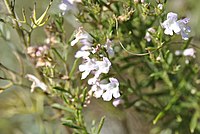
Photo from wikipedia
Lignin, a polymer found in the plant secondary cell wall, is a major contributor to biomass' recalcitrance toward saccharification. Because of this negative impact toward the value of lignocellulosic crops,… Click to show full abstract
Lignin, a polymer found in the plant secondary cell wall, is a major contributor to biomass' recalcitrance toward saccharification. Because of this negative impact toward the value of lignocellulosic crops, there is a special interest in modifying the content and composition of this important plant biopolymer. For many years this endeavor has been hindered by the plant growth inhibition that is often associated with manipulations to phenylpropanoid metabolism. Although the actual mechanism by which dwarfism arises remains unknown, recent advances in tissue-specific lignin complementation and better understanding of phenylpropanoid transcriptional regulation has made it possible to disentangle lignin modification from perturbations in plant development.
Journal Title: Current opinion in biotechnology
Year Published: 2019
Link to full text (if available)
Share on Social Media: Sign Up to like & get
recommendations!